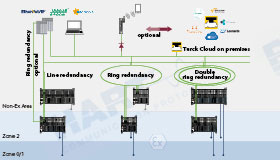Ethernet in Hazardous Areas

Ethernet in the Process Industry
Industrial Ethernet has been known for a long time in factory automation and is now also quite widespread. The special requirements of the process industry and especially of processes with potentially explosive atmospheres have so far not allowed the use of Ethernet. These requirements include intrinsic safety, configuration in run, redundancies for maximum availability and, last but not least, a long cable length, which is limited to 100 meters for industrial ethernet. When describing ethernet in the process industry, it is important to distinguish the potential with regard to the respective zones.
Why has Ethernet only just arrived in the process industry?
Industrial Ethernet has been known for a long time in factory automation and is now also quite widespread. The special requirements of the process industry, and in particular of processes with potentially explosive atmospheres, have not yet allowed the use of Ethernet. These requirements include intrinsic safety, configuration during operation, redundancies for maximum availability, and last but not least a long cable length, which is limited to 100 meters for Industrial Ethernet.
When describing ethernet in the process industry, it is important to distinguish the potential with regard to the respective zones.
Ex zone 2
Turck offers its I/O system excom with ethernet for installation in zone 2. The system can pick up signals from zone 1 or 0. To plug and unplug the ethernet connectors at the gateway in run, it must be ensured that the gateways are de-energized or work with a hot work permit. All other components such as power supply units, gateways or I/O modules can be exchanged during operation without hot work permit
Ethernet for Zone 1
Using ethernet in Ex zone 1 is technically more difficult. With interlinked devices, it must be ensured that power levels do not add up. An association of automation companies has set itself the goal of overcoming these hurdles and developing a standard for a two-wire intrinsically safe ethernet. Communication and power supply take place over the same line. The future standard is usually referred to as Advanced Physical Layer (APL). However, these developments are not yet suitable for broad industrial use in Zone 1 (status 03/2020). One day, APL should enable Ethernet connections up to the field devices. However, classic 4 to 20 mA technology and I/O systems will continue to exist in parallel for cost reasons alone, even after APL has been established.
- Technologies
- Asset Monitoring Gateway with Cloud ID
- Asset Monitoring Gateway with SNAP ID
- Codesys
- Condition Monitoring
- Ethernet in Hazardous Locations
- Field Logic Controller
- Industrial Cloud
- Industry 4.0
- IO-Link
- Machine Safety
- Modular Machines
- Module Type Package
- Multiprotocol Ethernet
- Pick-to-Light
- Profinet
- RFID
- Snap Signal
- Sustainability
- TAS – IIoT Service Platform
- The Visual Factory


